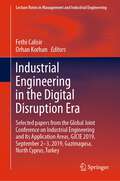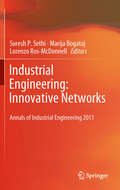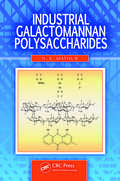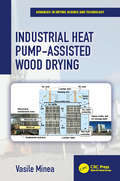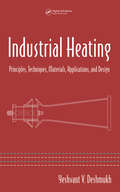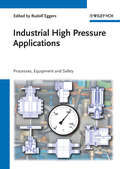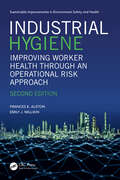- Table View
- List View
Industrial Engineering in the Age of Business Intelligence: Selected Papers from the Virtual Global Joint Conference on Industrial Engineering and Its Application Areas, GJCIE 2021, October 30–31, 2021 (Lecture Notes in Management and Industrial Engineering)
by Fethi CalisirThis book gathers extended versions of the best papers presented at the Global Joint Conference on Industrial Engineering and Its Application Areas (GJCIE), held virtually on October 30–31, 2021, from Istanbul Technical University. Continuing the tradition of previous volumes, it highlights recent developments of industrial engineering at the purpose of using and managing digital and intelligent technologies for application to a wide range of field, including manufacturing, healthcare, e-commerce and mobility.
Industrial Engineering in the Big Data Era: Selected Papers from the Global Joint Conference on Industrial Engineering and Its Application Areas, GJCIE 2018, June 21–22, 2018, Nevsehir, Turkey (Lecture Notes in Management and Industrial Engineering)
by Emre Cevikcan Fethi Calisir Hatice Camgoz AkdagThis book gathers extended versions of the best papers presented at the Global Joint Conference on Industrial Engineering and Its Application Areas (GJCIE), held in Nevsehir, Turkey, on June 21-22, 2018. They reports on industrial engineering methods and applications, with a special focus on the advantages and challenges posed by Big data in this field. The book covers a wide range of topics, including decision making, optimization, supply chain management and quality control.
Industrial Engineering in the Covid-19 Era: Selected Papers from the Hybrid Global Joint Conference on Industrial Engineering and Its Application Areas, GJCIE 2022, October 29-30, 2022 (Lecture Notes in Management and Industrial Engineering)
by Fethi Calisir Murat DurucuThis book gathers extended versions of the best papers presented at the Global Joint Conference on Industrial Engineering and Its Application Areas (GJCIE), held as a hybrid event on October 29–30, 2022, in/from Istanbul Technical University. Continuing the tradition of previous volumes, it highlights recent developments of industrial engineering at the purpose of using and managing digital and intelligent technologies for application to a wide range of field, including manufacturing, healthcare, e-commerce and sustainable development. A special emphasis is given to engineering methods and strategies for managing pandemics and reducing their adverse effects on businesses.
Industrial Engineering in the Digital Disruption Era: Selected papers from the Global Joint Conference on Industrial Engineering and Its Application Areas, GJCIE 2019, September 2-3, 2019, Gazimagusa, North Cyprus, Turkey (Lecture Notes in Management and Industrial Engineering)
by Fethi Calisir Orhan KorhanThis book gathers extended versions of the best papers presented at the Global Joint Conference on Industrial Engineering and Its Application Areas (GJCIE), held on September 2–3, 2019, in Gazimagusa, North Cyprus, Turkey. It covers a wide range of topics, including decision analysis, supply chain management, systems modelling and quality control. Further, special emphasis is placed on the state of the art and the challenges of digital disruption, as well as effective strategies that can be used to change organizational structures and eliminate the barriers that are keeping industries from taking full advantage of today’s digital technologies.
Industrial Engineering in the Era of Artificial Intelligence: Selected Papers from the Hybrid Global Joint Conference on Industrial Engineering and Its Application Areas, GJCIE 2024, August 7-9, 2024, Antalya, Turkey (Lecture Notes in Management and Industrial Engineering)
by Fethi Calisir Murat Durucu Semail ÜlgenThis book gathers revised and extended versions of the best papers presented at the Global Joint Conference on Industrial Engineering and Its Application Areas (GJCIE 2024), held in/from Antalya, Turkey, on August 7-9, 2024, as a hybrid event. Continuing the tradition of previous volumes, the chapters highlight recent developments in industrial engineering methods for improving different kinds of business. Special emphasis is given to combined strategies integrating conventional engineering methods with intelligent algorithms and technologies, such as machine learning, artificial intelligence, and blockchain technology, to improve business efficiency, user engagement, and industrial performance.
Industrial Engineering in the Industry 4.0 Era: Selected Papers from ISPR2023, October 5-7, 2023, Antalya (Lecture Notes in Mechanical Engineering)
by Numan M. Durakbasa M. Güneş GençyılmazThis book contains selected papers from International Symposium for Production Research 2023, held on October 5–7, 2023, Antalya, Türkiye. The book reports recent advances in production engineering and operations. It explores topics including: production research; production management; operations management; Industry 4.0; Industry 5.0; industrial engineering; mechanical engineering; engineering management; operational research. Presenting real-life applications, case studies, and mathematical models, this book is of interest to researchers, academics, and practitioners in the field of production and operation engineering. It provides both the results of recent research and practical solutions to real-world problems.
Industrial Engineering in the Internet-of-Things World: Selected Papers from the Virtual Global Joint Conference on Industrial Engineering and Its Application Areas, GJCIE 2020, August 14–15, 2020 (Lecture Notes in Management and Industrial Engineering)
by Fethi CalisirThis book gathers extended versions of the best papers presented at the Global Joint Conference on Industrial Engineering and Its Application Areas (GJCIE), organized virtually on August 14–15, 2020, by Istanbul Technical University. It covers a wide range of topics, including decision analysis, supply chain management, systems modelling and quality control. Further, special emphasis is placed on cutting-edge applications of industrial Internet-of-Things. Technological, economic and business challenges are discussed in detail, presenting effective strategies that can be used to modernize current structures, eliminating the barriers that are keeping industries from taking full advantage of IoT technologies. The book offers an important link between technological research and industry best practices, and covers various disciplinary areas such as manufacturing, healthcare and service engineering, among others.
Industrial Engineering in the Sustainability Era: Selected Papers from the Hybrid Global Joint Conference on Industrial Engineering and Its Application Areas, GJCIE 2023, August 14–16, 2023, New York, USA (Lecture Notes in Management and Industrial Engineering)
by Fethi Calisir Murat Durucu Mohammad T. KhasawnehThis book gathers extended versions of the best papers presented at the Global Joint Conference on Industrial Engineering and Its Application Areas (GJCIE), held on August 14-16, 2023, in New York, USA. Continuing the tradition of previous volumes, it highlights recent developments of industrial engineering and digital and intelligent technologies for improving manufacturing processes, and healthcare and transportation services, among others applications. A special emphasis is given to engineering methods and strategies fostering a sustainable business development.
Industrial Engineering: Innovative Networks
by Marija Bogataj Suresh P. Sethi Lorenzo Ros-McdonnellThe Spanish Conference of Industrial Engineering /Ingeniería de Organización Industrial (CIO) is an annual meeting promoted by Asociación para el Desarrollo de la Ingeniería de Organización/ Industrial Engineers Association (ADINGOR). The aim of CIO is to establish a forum for the open and free exchange of ideas, opinions and academic experiences about research, technology transfer or successful business experiences in the field of Industrial Engineering. The Scientific Committee is composed by 68 international referees and we foresee the attendance of some 200 people from more than 15 countries and following the rotation of venue and organization between various Spanish universities, the 2011 Conference will be the fifteenth National Conference and the fifth International Conference in Cartagena. During three days the 2011 Conference will include the participation of European and other foreign countries researchers and practitioners that will presenting communications, reproduced in this volume, on a range of topics including: Production and Operations Business Management Supply Chain Management Economic environment Technological and Organizational Innovation and Management and Innovation in Education The Conference on Industrial Engineering (CIO) and its proceedings are an excellent platform for the dissemination of the outputs of the scientific projects developed in the frame of the European, national or regional Research and Development plans.
Industrial Explosives and their Applications for Rock Excavation
by Marilena Cardu Daniele Martinelli Carmine TodaroIndustrial Explosives and their Applications for Rock Excavation focuses on applications of industrial explosives in civil and mining engineering works. Explosives and their actions are explained in terms of basics, principles, and related chemistry. Explosives and initiation devices are described, including their characteristics, geometry, and timing aspects of the blast design. Designing blasts for rock excavation works is explained, including devices for obtaining large-sized blocks, construction of yards, and excavation of big foundations. Finally, criteria for the mitigation of the associated seismic disturbances are summarized.The book: provides an updated vision of industrial explosives, including the best technical advice for rock excavation; contains harmonized preliminary modules aimed at introducing basic concepts of chemistry and physics applied to the drilling and blasting technique; defines balanced mix of theory capable of providing skills to design an efficient blasting; covers excavation problems from different points of view and in different contexts; and addresses issues of drilling and loading blast-holes. Industrial Explosives and their Applications for Rock Excavation is aimed at graduate students, researchers, and professionals in mining engineering and explosives technology.
Industrial Fire Protection Handbook
by R. Craig SchrollFundamentally, fire prevention and control refer to systems and practices that increase a facility's ability to avoid fires, limit the development and spread of fires, and rapidly and effectively control fires. Changing safety codes and regulations along with recent technological advances have rendered the first edition of this popular handbook som
Industrial Fluid Power: Volume 1
by Charles HedgesBasic Textbook on Hydraulics, Pneumatics and Vacuum. Study Text, Circuit Diagrams, Design Data Tables and Troubleshooting arranged for the Beginning Student.
Industrial Forests and Mechanical Marvels
by Teresa CribelliAn account of modernization and technological innovation in nineteenth-century Brazil that provides a distinctly Brazilian perspective. Existing scholarship on the period describes the beginnings of Brazilian modernization as a European or North American import dependent on foreign capital, transfers of technology, and philosophical inspiration. Promoters of modernization were considered few in number, derivative in their thinking, or thwarted by an entrenched slaveholding elite hostile to industrialization. Teresa Cribelli presents a more nuanced picture. Nineteenth-century Brazilians selected among the transnational flow of ideas and technologies with care and attention to the specific conditions of their tropical nation. Studying underutilized sources, Cribelli illuminates a distinctly Brazilian vision of modernization that challenges the view that Brazil, a nation dependent on slave labor for much of the nineteenth century, was merely reactive in the face of the modernization models of the North Atlantic industrializing nations.
Industrial Galactomannan Polysaccharides
by N. K. MathurQuite possibly the first comprehensive text on galactomannans, Industrial Galactomannan Polysaccharides compiles information on their industrial uses in the form of gums including locust bean, guar, tara, fenugreek, cassia-tara, and Sesbania-bisipinasa varieties. The book describes how galactomannans are currently produced commercially and how they
Industrial Gas Flaring Practices
by Nicholas P. CheremisinoffThis volume tackles for the first time in decades the world's gas flaring practices, a difficult, hot-button issue of our time, whose consequences are only just beginning to be understood. The book examines both the technical and environmental aspects of gas flaring, highlights different flare designs, and presents real-world case studies illustrating the proper use of gas flaring and how to avoid polluting flaring events. The only guide of its kind, this remarkable book can help professionals in the oil and gas industry take an important step toward reducing worldwide CO2 emissions.
Industrial Gas Handbook: Gas Separation and Purification
by Frank G. KerryDrawing on Frank G. Kerry's more than 60 years of experience as a practicing engineer, the Industrial Gas Handbook: Gas Separation and Purification provides from-the-trenches advice that helps practicing engineers master and advance in the field. It offers detailed discussions and up-to-date approaches to process cycles for cryogenic separation of
Industrial Growth in New York
by Holly CefreyA book about the growth of industries in New York City.
Industrial Heat Pump-Assisted Wood Drying (Advances in Drying Science and Technology)
by Vasile MineaThis book discusses conventional as well as unconventional wood drying technologies. It covers fundamental thermophysical and energetic aspects and integrates two complex thermodynamic systems, conventional kilns and heat pumps, aimed at improving the energy performance of dryers and the final quality of dried lumber. It discusses advanced components, kiln energy requirements, modeling, and software and emphasizes dryer/heat pump optimum coupling, control, and energy efficiency. Problems are included in most chapters as practical, numerical examples for process and system/components calculation and design. The book presents promising advancements and R&D challenges and future requirements.
Industrial Heating: Principles, Techniques, Materials, Applications, and Design
by Yeshvant V. DeshmukhIndustry relies on heating for a wide variety of processes involving a broad range of materials. Each process and material requires heating methods suitable to its properties and the desired outcome. Despite this, the literature lacks a general reference on design techniques for heating, especially for small- and medium-sized applications. Industri
Industrial High Pressure Applications: Processes, Equipment, and Safety
by Rudolf EggersIndustrial high pressure processes open the door to many reactions that are not possible under 'normal' conditions. These are to be found in such different areas as polymerization, catalytic reactions, separations, oil and gas recovery, food processing, biocatalysis and more. The most famous high pressure process is the so-called Haber-Bosch process used for fertilizers and which was awarded a Nobel prize. Following an introduction on historical development, the current state, and future trends, this timely and comprehensive publication goes on to describe different industrial processes, including methanol and other catalytic syntheses, polymerization and renewable energy processes, before covering safety and equipment issues. With its excellent choice of industrial contributions, this handbook offers high quality information not found elsewhere, making it invaluable reading for a broad and interdisciplinary audience.
Industrial Hydraulic Systems: Theory and Practice
by Joji ParambathIndustrial Hydraulic Systems provides an in-depth coverage of conventional hydraulic systems encompassing ? fixed-displacement pumps, control valves, and actuators as well as the most modern hydraulic systems encompassing highly efficient variable-displacement pumps, electro-hydraulic proportional valves and/or servo valves with integrated electronics. The coverage is further supplemented by many typical hydraulic and electro-hydraulic circuits. Details of di?fferent types of auxiliary devices such as reservoirs, ?filters, accumulators, and piping have also been described in this book. Topics on hydrostatic transmission, cartridge valves, load sensing pump controls, ?fluids, ?filters, and seals are given in detail. Design, installation, and maintenance aspects of hydraulic systems are added to make the book more useful to actual practitioners of these systems. Understanding the fundamental laws and principles allows the reader to use basic theoretical concepts in practical applications. The unique feature of this textbook is that all quantities are given in the SI system as well as in the English system of units. This book provides an extensive coverage of fluid power to designers, engineers, technicians, and students of engineering colleges, polytechnics, and vocational training institutes. This book, prepared especially with an academic interest in mind, contains a large number of numerical examples, design problems, and sections for ‘Test your Knowledge’ and end of chapter questions. This book is intended to provide the most current information available on hydraulic technology.
Industrial Hygiene Control of Airborne Chemical Hazards, Second Edition
by William PopendorfAre you a practicing occupational hygienist wondering how to find a substitute organic solvent that is safer to use than the hazardous one your company is using? Chapter 6 is your resource. Are you a new hygienist looking for an alternative technology as a nonventilation substitute for an existing hazard? Chapter 8 is your resource. Are you looking for an overview of ventilation? Chapters 10 and 11 are your resource? Are you an industrial hygiene student wanting to learn about local exhaust ventilation? Chapters 13 through 16 are your resource. Are you needing to learn about personal protective equipment and respirators? Chapters 21 and 22 are your resources. This new edition brings all of these topics and more right up-to-date with new material in each chapter, including new governmental regulations. While many of the controls of airborne hazards have their origins in engineering, this author has been diligent in explaining concepts, writing equations in understandable terms, and covering the topics of non-ventilation controls, both local exhaust and general ventilation, and receiver controls at the level needed by most IHs without getting too advanced. Taken as a whole, this book provides a unique, comprehensive tool to learn the challenging yet rewarding role that industrial hygiene can play in controlling airborne chemical hazards at work. Most chapters contain a set of practice problems with the solutions available to instructors. Features Written for the novice industrial hygienist but useful to prepare for ABIH certification Explains engineering concepts but requires no prior engineering background Includes specific learning goals that differentiate the depth of learning appropriate to each topic within the fuller information and explanations provided for each chapter Contains updated governmental regulations and abundant references Presents a consistent teaching philosophy and approach throughout the book Deals with both ventilation and non-ventilation controls
Industrial Hygiene in the Pharmaceutical and Consumer Healthcare Industries (Drugs and the Pharmaceutical Sciences)
by Casey C. CosnerThis volume is an update on the use of containment in the pharmaceutical industry and consumer healthcare. It serves to highlight how industrial hygiene acts as a driving force within these industries to reduce the risk of exposure to chemical and physical agents, particularly to powders and dusts, while taking all factors into account. The author emphasizes how this book is not designed to replace other texts on containment; rather, it will serve to show a practical approach of utilizing the technologies within the high-demand industries of pharmaceuticals and consumer healthcare. Features: Timely coverage of changes in process control technology for the phamaceutical industry, a dynamic area in terms of products and manufacturing processes Provides an update on the unique requirements of these industries and how they differ from others, for example the microelectronics or specialized chemicals industries Draws on the author's vast experience in the field of industrial hygiene and hazardous materials Presents a collection of unique situations in which industrial hygiene was implemented to resolve a variety of scenarios and did not interfere with quality issues Addresses current topics relating to industry evolution such as migration of therapies to higher potency, RiskMAP, new modalities in medicines and treatments, large molecule therapeutics and conjugates
Industrial Hygiene: Improving Worker Health through an Operational Risk Approach (Sustainable Improvements in Environment Safety and Health)
by Frances Alston Emily J. Millikin Willie PiispanenOver the past forty years, the Industrial Hygiene profession has significantly grown, and is expected to continue to grow as workplaces evolve in the development, management, and usage of hazardous materials. This growth in the profession is also related to the shift in public knowledge and perception regarding the acceptance of the health risk from activities performed at work and home. As time progresses, workplaces are being regulated to not only minimize the health imparts to the workforce, but also decrease the likelihood of negatively impacting the environment. Society has become more educated on the potential impacts on human health and the environment that hazardous materials, activities, and environments can pose. As such, there has been a noticeable decrease in the acceptance of risk by workers and the public. The accepted standard of performance for Industrial Hygiene has grown beyond compliance, but now also focuses on improving existing processes and practices to create a workplace free from work related injury and illness. <P><P>Features: <li>Shows application of risk mitigating techniques for industrial hygienists <li>Explains the definition of risk and how it applies to health and safety management <li>Defines the need for quality data management and continuous improvement in assessments <li>Describes the role of the Industrial Hygienist and risk management when responding to emergencies <P><P>Industrial Hygiene: Improving Worker Health through an Operational Risk Approach focuses on the implementation of Industrial Hygiene, using a risk-based approach, in an operational environment. The approaches and methods described in this book are designed to assist the Industrial Hygienist in managing workplace risks, including risks associated with anticipation, recognition, evaluation, and hazard control processes.
Industrial Hygiene: Improving Worker Health through an Operational Risk Approach, Second Edition (Sustainable Improvements in Environment Safety and Health)
by Frances Alston Emily MillikinSociety has become more educated on the impacts on human health and environment, and there has been a noticeable decrease in the acceptance of this risk by workers and the public. However, to ensure a higher level of worker protection, a revised approach to industrial hygiene is needed focusing on risk-reduction. This second edition of Industrial Hygiene focuses on implementation of an industrial hygiene program, using a risk-based approach, in an operational environment. Key elements of this book include balancing the art and science of industrial hygiene, risk-based industrial hygiene approaches, recognizing, evaluating, and controlling workplace hazards, medical monitoring for workers, emergency response, training, and evaluating industrial hygiene programs. Updated concepts on leadership, emergency response and monitoring, management of industrial hygiene projects, and risk communication are addressed in this edition. The book incorporates the ISO 45001 standard, “Occupational Health and Safety,” into an industrial hygiene program, which further demonstrates a risk-based approach that is internationally recognized. This is an ideal read for any student, researcher, or practitioner in the fields of occupational health and safety, industrial hygiene, risk management, and hazard control. New case studies with proposed solutions underpin the learning, and the instructor resource pack comprising PowerPoint presentations, question bank, and resources to enhance learning are available in this edition for qualified textbook adoption.



